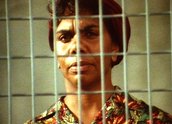

Shadow Panic (1989)
Synopsis
Shadow Panic is a short experimental drama in which three women characters – 'The Redhead’, 'The Investigator’ and 'The Hothead’ – seem to be inextricably linked through memory, dreams and an increasing state of emergency. Unknown to each other, their paths accidentally cross in the film. Poetic and dreamlike, the film uses striking visuals and a fragmented atmospheric soundtrack to evoke memories and feelings of threat and chaos in the lives of its three women characters.
Curator’s notes
Margot Nash’s previous experimental film We Aim to Please (1976), made with Robin Laurie, foreshadowed this film. Both were produced by AS IF Productions (an acronym for Anarcho Surrealist Insurrectionary Feminists) and feature Robin Laurie as one of the characters. But this time Margot Nash wrote, directed and produced.
As in the earlier work, Margot Nash uses fragments of voice and evocative sound effects against highly constructed symbolism to give new meaning to the image of women in the film. But there are important developments in this film. Most significant is the inclusion of an Indigenous woman character. This interest in dramatically portraying the Indigenous experience has continued to be an important element in the filmmaker’s subsequent features – Vacant Possession in 1994 and Call Me Mum in 2005 (see clip one).
Shadow Panic was best described by the filmmaker herself in 1989:
Making Shadow Panic was an experiment in structure. By working only with fragments connected via the gaze, via chance, by shaking up narrative expectations, I hoped to create an atmosphere where the poetic, the fantastic, could find expression. I wanted to work with the unconscious, not with logic, to create images that might resonate later, much as a dream might.
These ideas reflected the influence at the time on Australian feminist filmmaking of the French screen theorists, in particular Hélène Cixous and the filmmaker Maya Deren.
The sound and images in Shadow Panic are evocative of emotional states, not a linear story. Quotes, thoughts and poems are heard over highly constructed symbolic images. Each of the characters could be seen as an aspect of the one self: the Redhead has a memory of her power in childhood, the Investigator is challenging corrupt male power and the Hothead is searching for love. This is all set within an increasingly threatening landscape of corruption, nuclear accident, volcanic eruptions, chaos and madness until the film is humorously resolved with the song 'Me and My Shadow’ referring to the Jungian idea of 'shadow’ as the dark emotions we disown.
Without doubt the power of this film lies with its visuals. The combined vision of Margot Nash’s direction, the superb cinematography of Sally Bongers and Jan Mackay’s art direction ensure that the film is a visual feast. Acclaimed composer Elizabeth Drake designed the sound and wrote the music which contributes to the overall dreamlike quality of the film (see clip two).
Shadow Panic was released theatrically in Australia on 26 July 1990, distributed by the Australian Film Institute. It also screened in 1989 in London supporting Chantal Akerman’s feature Toute Une Nuit (1982). Shadow Panic screened at many Australian and overseas festivals and was awarded the 1990 Red Ribbon at the American Film and Video Festival, the Innovation Award at the ATOM Awards, Best Cinematography at the 1989 AFI Awards and was a finalist in the Dendy Awards at the 1989 Sydney Film Festival. It was first broadcast on SBS television on 26 September 1991.
- Overview
- Curator’s notes
- Video 2 clips
- Principal credits
- Find a copy
- Make a comment
- Map
- Add your review



